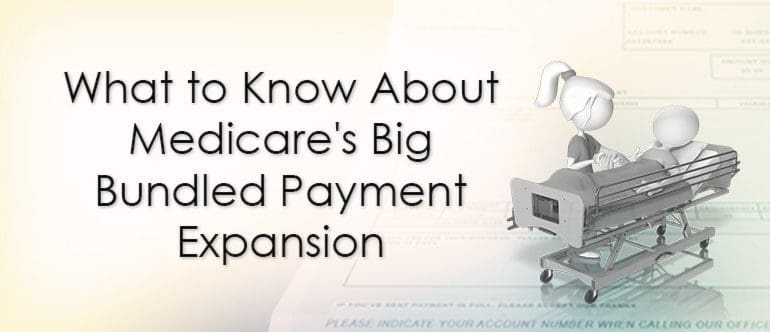Call us toll-free: 800-878-7828 — Monday - Friday — 8AM - 5PM EST


By Elizabeth Whitman for Modern Healthcare
A new mandatory program the CMS proposed Monday would make hospitals in 98 markets financially accountable for the cost and quality of all care associated with bypass surgery and heart attacks.
“We think it’s important to keep pushing forward on delivery system reform,” Dr. Patrick Conway, acting principal deputy administrator and chief medical officer for the CMS, told reporters in a call. “We think this is a huge opportunity.”
In 2014, hospitalizations for heart attacks for more than 200,000 beneficiaries cost Medicare over $6 billion, the CMS said. Yet for every treatment, the cost could vary by as much as 50%, the agency said.
The CMS is seeking comment on the five-year demonstration, which would take effect July 1, 2017, in 98 randomly selected metropolitan areas.
The CMS also plans to expand its first and mandatory bundled-payment model—which took effect in January and covers total hip and knee replacements—to include surgeries repairing hip and femur fractures.
Stakeholders and observers had long speculated that cardiac procedures would be next in the expansion of bundled payment models.
The change comes as part of a broader nationwide shift toward value-based payment systems that aim to reward doctors, hospitals and other providers for quality over quantity of care. The administration aims by 2018 to have half of traditional Medicare payments go through alternative payment models.
The expansion of bundles to cardiac care is evidence that the value-based payment movement has gained substantial momentum with the government and private payers alike, said Dr. Susan Nedza, a former chief medical officer at the CMS who is now a senior vice president at MPA Healthcare Solutions.
“We’ve often talked about a tipping point in the movement from fee-for-service to alternative payment models, and I believe today is the day,” Nedza said.
In a bundled payment model, the government reimburses providers a set amount per patient for one episode of care, such as a knee replacement, rather than paying for every individual service rendered as part of that procedure. The idea is to create a financial incentive for providers to better coordinate care and keep costs down.
As with the joint-replacement bundles, the CMS would set target prices each year based on historical regional data and hospital-specific data for the hospitalization and related care for 90 days after the patient is discharged. Hospitals that beat the target while meeting quality benchmarks would get to keep the savings. Those that exceed the targets would have to pay Medicare back at the end of the year.
The calculation will shift from relying mostly on hospital-specific data in the first two years of the program to only regional data in the final two years.
The financial risk would also be phased in. No repayments would be required for the first 15 months of the program and would be capped at 5% for the remainder of the second year. Losses would be limited to 10% in year three and 20% in the final two years. The rewards would follow a similar schedule, though hospitals could keep as much as 5% in the first two years.
The CMS has not yet selected the areas where hospitals would be compelled to participate, but the proposed rule does identify 90 areas that would be excluded.
So far, bundled payments have been found to reduce spending, but not overwhelmingly so. A three-year experiment by the CMS, the Acute Care Episode Demonstration, that included 28 cardiac and nine orthopedic procedures led to savings of $319 per patient.
The bundled-payment program for hip and knee replacements, known formally as the Comprehensive Care for Joint Replacement model, affects 800 hospitals across 67 metropolitan areas in the U.S.
The American Hospital Association said the changes to that program and the addition of the cardiac bundles could pose challenges for hospitals.
“The proposal to bundle payments for cardiac care is the third mandatory demonstration project from CMS in a little over a year,” the group said in a statement. The proliferation of new programs and changes to existing ones is “putting the success of these critical programs at risk.”
American College of Cardiology President Dr. Richard A. Chazal expressed support for the proposal but also urged the CMS to listen to feedback from providers and give them adequate time and resources to implement the model. “Changes in payment structures in health care can pose significant challenges to clinicians and must be driven by clinical practices that improve patient outcomes,” Chazal said in a statement.
Chazal and the hospital association both praised another significant provision of the 900-page proposal: allowing physicians in the cardiac and joint programs to qualify as participating in “advanced alternative payment models” under the framework of the Medicare Access and Chip Reauthorization Act. That means they would be exempt from a matrix of quality reporting and performance requirements established by the new payment system and also qualify for bonuses.
Yet another provision would encourage the use of cardiac rehabilitation. The CMS noted that even though rehab has been shown to reduce the risk of a second heart attack or death, a mere 15% of heart attack patients receive such care.
That model would create new financial incentives for hospitals in 45 geographic areas, distinct from the regions included in the cardiac care bundled payment models. Hospitals would receive $25 per rehabilitation service, for up to 11 services, for patients receiving care after a heart attack or bypass surgery.
